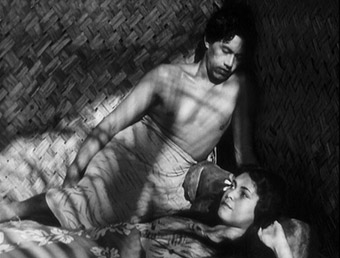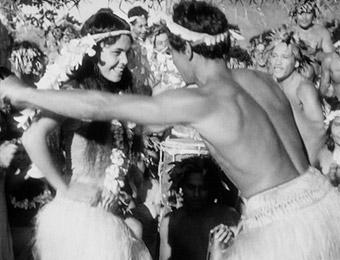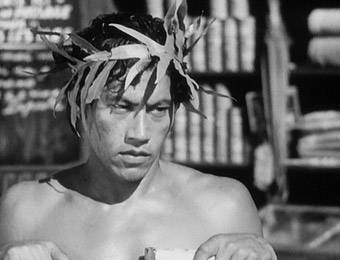|
As I retrospectively discover the work of Frederick Wilhelm Murnau, I know I should stop being surprised by what I see, but I somehow never do, and I mean that in the best of ways. I'm well aware that I've said this before, but most of us tend to approach anything labeled 'silent cinema' with specific expectations for its form and style, and can thus experience a jolt when the film in question not only refuses to conform to these preconceived notions, but leaves them for dust. Murnau does it repeatedly – he did it with Sunrise, he did it with Faust, and he did it with The Last Laugh. He certainly does it with his final film, Tabu.
Those of you who know your film history (or who read our news story about this DVD release) will know that F.W. Murnau is only half of the filmmaking story here, and that the project was orginally planned as a collaboration between him and documentary giant Robert Flaherty. Flaherty's 1922 Nanook of the North is often cited as the godfather of the documentary feature, while his 1926 Moana inspired John Grierson to first coin the term 'documentary' in relation to non-fiction filmmaking. It seems an unlikely partnership, a visionary dramatist with an enthusiasm for cinematic experimentation and a factual observer whose cinematic approach was resolutely observational, despite his later rep for doctoring reality.

At first glance, the unspoiled South Seas location and its close-to-nature people seem a lot more Flaherty than Murnau. Flaherty had already explored this territory in Moana – also sub-titled A Story of the South Seas in the USA – but for Murnau the opportunity to make such a film was a long held dream, one that his increasing dissatisfaction with his experience in Hollywood helped push him to realise. Initially equal partners, the two filmmakers soon fell out, with Murnau moving into the director's chair and Flaherty sidelined to supervising the lab work. Even Flaherty's initial role as cameraman was usurped when his camera began chewing up film, prompting Murnau to hire relative newcomer Floyd Crosby to take his place. It all sounds like a recipe for disaster, but the result is genuinely astonishing, a uniquely beautiful story of love, rebellion, exploitation and tragedy.
On an idyllic island paradise in the Bora Bora lagoon, young Matahi has fallen for the beautiful Reri. Before he can claim her as his partner, however, she is selected by Hitu, an elder from a neighbouring island, to fulfil the role of Sacred Virgin, a symbol of all that is pure and honourable in their people. A decree is issued proclaiming that no man may touch her or cast his eye on her in desire: "Sacred is Reri. From this time forth she is tabu. To break this tabu means death." Unwilling to oppose the law of their people, both Matahi and Reri are distraught, but shortly after Reri is taken by Hitu she is abducted by Matahi, and the two flee to another island to start a new life together there. But this island is under the control of the white man, and although Matahi soon finds work as a skilled pearl diver, he has no understanding of the concept of monetary trade, and Hitu has no intention of just letting Reri walk away from her sacred duty.
Stories of love in the face of impossible odds are as old as drama itself, and yet even eighty-six years after it was made, so much of Tabu still feels fresh and innovative. Central to this are its characters and setting, specifically the decision to present the story almost entirely from Matahi and Reri's viewpoint and to cast every role authentically, mainly from the local populace. As a result, even familiar scenes are presented from an angle we are not simply used to seeing. Just twelve minutes in, for instance, there's a sequence in which a flotilla of native canoes paddle enthusiatically out to greet the arrival of a large ship, an image you'll find in almost every historical drama in which white travllers have visited South Sea Islands, including all versions of Mutiny on the Bounty. And yet how often have you seen it shown exclusively from the viewpoint of the approaching canoes?

This may seem a small thing in a movie that runs for 82 minutes, but it's one of many alternative takes on what has been rendered familiar by subsequent films, and that's talking from a modern perspective. On its release it must have seemed genuinely revolutionary, not least in its suggestion that the ways of the so-called 'civilised' societies – particularly the concept of monetary trade – have a corrupting and destructive effect on those who had no need of them in the first place. Matahi learns about capitalism not through observation or instruction (it is made clear that despite his prized diving skills, he remains unrewarded for his work and kept in ignorance of his rights), but through the morally damaging experiences of bribery and crippling debt. And at a time when studio films assume that an audience is incapable of identifying with lead characters who do not fit into their own narrow demographic, it's inspiring to look back at a film from 1931 in which we form a tight emotional bond with people who do not reflect our own culture or ethnic background and who are presented as warm, vibrant, instantly likeable, attractive and openly sensual.
Cinematically, the film is consistently thrilling without employing any of the experimental techniques that Murnau used to such striking effect in films such as Faust and Sunrise. In Tabu, it's all in the editing, the cinematography and the music (when Tabu was completed, sound cinema was already in full swing, but the only audio here is Hugo Riesenfeld's lively score), each impressive in their own right but working in harmony to sometimes electrifying effect. Much of the film bristles with an energy that radiates from the natives' passion for life, exemplified in the hyper-exuberant and sexually charged dance that Matahi and Reri engage in, an act of passion that is also their first direct challenge to Hitu's presence and word of law. On their commentary track, R. Dixon Smith and Brad Stevens make a case Hitu's stillness as a force of destruction in opposition to this energy, and as the film progresses it's hard not to agree. While the vibrant Matahi and Reri represent youth, life and freedom, Hitu, like the slow-moving figure of Count Orlock in Murnau's Nosferatu, is a symbol of oppression, conformity and death.
Murnau moves into Flaherty's turf as if born to it and in the process puts his stamp on almost every aspect of the film, from the fate of its lead characters to the underlying themes and motifs, and the arrangement of action and framing of shots to suggest so much more than they actually show. There will be few fans of the director's work, for example, who will not recognise the mirroring of one of Nosferatu's most memorable images, a ship that slides slowly into port and film frame to signify the approach of doom for the lead characters.

There's a sad poetry to the fact that Murnau's death coincided with that of silent cinema. A true master of visual story telling, he was increasingly rejecting the use of intertitles, silent cinema's soundtrack substitute, in favour of a purely cinematic approach in which story and emotion could be conveyed purely through performance, cinematography and editing. This is particularly evident in The Last Laugh, which apart from an captioned epilogue has no intertitles at all, while those in Tabu, except for the two chapter introductions, are all from documents within the story.
Tabu is extraordinary cinema, and seen from a modern perspective feels years ahead of its time, playing less like a silent movie than a film in which the director has freely chosen chosen to tell its story purely through imagery and music. The photography is gorgeous (Crosby bagged an Oscar for his work here), the performances disarmingly naturalistic, and the editing as tight and purposeful as anything you'll find in the cinema of today. Best and most important of all is its effectiveness as drama, a compellingly told and genuinely moving story that boasts a wealth of allegorical depth and a deeply human heart.
Another superb reconstruction by F.W. Murnau-Stiftung, the company responsible for the eye-popping restoration wok on Nosferatu. Apart from the odd dust spot – and even they are rare – this is a miraculous transfer for a film of this vintage that betrays only the faintest traces of print damage. There are some slight burnouts on some of the whites, but the support material suggest this may have been the result of the conditions under which the original film stock was developed. In all other respects the image quality is exceptional, with excellent contrast and detail, and black levels that are as solid as they come. This is also the complete version of the film as it was originally intended to be seen, and thus a considerable improvement over the previous Paramount and Samuel Brown versions, both of which were cut, with the removal of all nudity from the latter version apparently rendering entire scenes incomprehensible.

The original mono soundtrack has been preserved and cleaned up, and although a long way from the pristine clarity and fidelity of modern tracks, it still sounds a lot better than you'd expect of a film of this age.
Commentary by R. Dixon Smith and Brad Stevens
One of those expert commentaries it would be terribly easy to be cynical about, particularly in the way the two discuss motifs and meanings that you can't initially help thinking were probably more the result of logic or coincidence than planning (Hitu's slow movement, for instance, could be passed off as a common trait of characters in positions of authority), but their arguments become increasingly persuasive as the film progresses as the motifs are repeated with obvious purpose. They provide useful detail on the material cut or altered for the Paramount and Samuel Brown versions, and they are clearly huge admirers of a film they regard as Murnau's masterpiece.
Tabu – The Cinematic Legacy (14:52)
A documentary made by Luciano Berriatúa as part of the series for F.W. Murnau-Stiftung that kicked off with the one you'll find on Masters of Cinema's recent Nosferatu DVD. Although considerably shorter than its predecessor, the programme is busy with useful material, some of which is not covered elsewhere in the package, including the Murnau/Walter Spies concept of 'architectural cinematography', a side-by-side compassion of two angles of the same shots, and footage not used in the film that was recycled by Murnau's brother Robert Plumpe for his own short films. The included extracts from the feature give you a good idea how it looked before the Murnau-Stiftung restoration.
Booklet
OK, I've emphasised the quality of the booklets that accompany Masters of Cinema DVD releases on a number of occasions, but it's got to the point where I feel I need to expand on this and emphasise just how comprehensive and well put together they are. The 80-page one accompanying Tabu is a typically excellent example, and is so packed with well chosen and informative material that were we talking a movie with a wider recognition base, then I'm sure it could be sold as a stand-alone product that would be snapped up by film enthusiasts. Consider the following inclusions: Sunrise in Bora Bora, an updated and detailed 1990 essay on the film by Scott Eyman, including a map of the region in which the filming took place; Flaherty and Tabu, a 1959 Film Culture article by Richard Griffith; Flaherty's Hollywood Period: The Crosby Version, a revealing interview with cameraman Floyd Crosby from 1976; A Story of the South Seas in Letters and Telegrams, a collection of extracts from telegrams and letters sent by and to Murnau during the shoot, including reproductions of actual documents; The Fire Spirit of Bora Bora: A Ghostly Experience from Murnau's South Pacific Diary, a newly translated article written by Murnau and originally published in 1940; Turia, an Original Story, Murnau and Flaherty's original treatment for the film that would eventually become Tabu; Tabu (Taboo), a Story of the South Seas, the more detailed reworking of the story that was written after Murnau took control of the project; Tabu: A Story of the South Seas, a 1931 article by Lotte H. Eisner, who would later write extensively about Murnau; A Song for Mr. Murnau, the lyrics of a song composed by a Punaavia native for the director; a number of high quality film and production stills; extracts of the original script, complete with Murnau's handwritten annotations. An excellent companion to the disc itself, the booklet – and I'm tempted to drop the suffix 'let' from that word – is a key reason to call this release definitive.
In some respects I've lost out coming straight to this version of Tabu, as I've not had the pleasure of seeing it gradually restored to its present close-to-perfect state over a period of years and through various video versions, as I did with Murnau's Nosferatu. What I've lost there I've gained in the increased impact this has very likely had on my first viewing of this extraordinary last shout for both Murnau and silent cinema. The Masters of Cinema DVD is a joy, boasting a superb transfer and a fine collection of extra features, including one of their best booklets yet. Highly recommended.
|